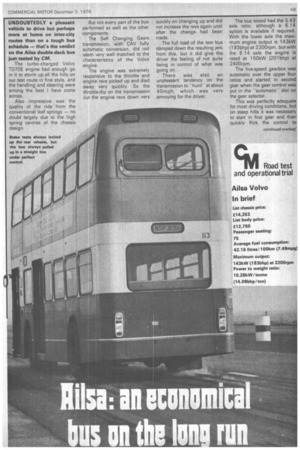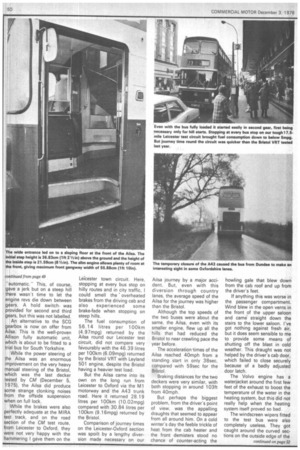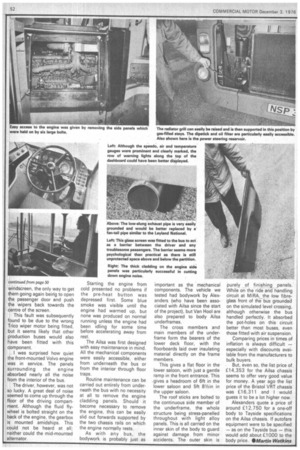UNDOUBTEDLY a pleasant vehicle to drive but perhaps more at
Page 53

Page 54

Page 56

If you've noticed an error in this article please click here to report it so we can fix it.
home on inter-city routes than on a tough bus schedule — that's the verdict on the AiIse double-deck bus just tested by CM.
The turbo-charged Volvo TD7OE engine had enough go in it to storm up all the hills on our test route in fine style, and the handling and steering were among the best I have come across.
Also impressive was the quality of the ride from the conventional leaf springs — no doubt largely due to the high spring centres of the chassis design.
But not every part of the bus performed as well as the other components.
The Self Changing Gears transmission, with CAV fully automatic conversion, did not seem very well matched to the characteristics of the Volvo engine.
The engine was extremely responsive to the throttle and engine revs picked up and died away very quickly. So the throttle-dip on the transmission cut the engine revs down very quickly on changing up and did not increase the revs again until after the change had been made.
The full load of the test bus damped down the resulting jerk from this, but it did give the driver the feeling of not quite being in control of what was going on..
There was also an unpleasant tendency on the transmission to "hunt" at about 40mph, which was very annoying for the driver. The bus tested had the 5.43 axle ratio, although a 6.14 option is available if required. With the lower axle the maximum engine output is 143kW (193bhp) at 2200rpm, but with the 6.14 axle the engine is rated at 150kW (201bhp) at 240Orpm.
The five-speed gearbox was automatic over the upper four ratios and started in second gear when the gear control was put in the "automatic" slot on the gear selector.
This was perfectly adequate for most driving conditions, but on steep hills it was necessary to start in first gear and then quickly flick the control to utomatic." This, of course, g ve a jerk but on a steep hill t re wasn't time to let the e gine revs die down between gars. A hold switch • was vided for second and third ars, but this was not labelled. An alternative to the SCG arbox is now on offer from sa. This is the well-proven !son fully automatic unit, 'ch is about to be fitted to a ri;l bus for South Yorkshire. While the power steering of Ailsa was an enormous provement on the very heavy nual steering of the Bristol, ich was the last decker ted by CM (December 5, 75), the Ailsa did produce o e strange clonking noises m the offside suspension en on full lock.
While the brakes were also ectly adequate at the MIRA t track, and on the road tion of the CM test route, m Leicester to Oxford, they re not very happy with the ha mering I gave them on the Leicester town circuit. Here, stopping at every bus stop on hilly routes and in city traffic, I could smell the 'overheated brakes from the driving cab and also experienced some brake-fade when stopping on steep hills.
The fuel consumption of 56.14 litres per 100km (4.97mpg) returned by the Ailsa round our Leicester test circuit, did not compare very favourably with the 46.39 litres per 100km (6.09mpg) returned by the Bristol VRT with Leyland 501 engine, despite the Bristol having a heavier test load.
But the Ailsa came into its own on the long run from Leicester to Oxford via the M1 motorway and the A43 trunk road. Here it returned 28.19 litres per 100km (10.02mpg) compared with 30.84 litres per 100km (9.16mpg) returned by the Bristol.
Comparison of journey times on the Leicester-Oxford section was spoilt by a lengthy diversion made necessary on our Ailsa journey by a major accident. But, even with this diversion through country lanes, the average speed of the Ailsa for the journey was higher than the Bristol.
Although the top speeds of the two buses were about the same, the Ailsa, even with its smaller engine, flew up all the hills that had reduced the Bristol to near crawling pace the year before.
The acceleration times of the Ailsa reached 40mph from a standing start in only 38sec, compared with 59sec for the Bristol.
Braking distances for the two deckers were very similar, with both stopping in around 103ft from 40mph.
But perhaps the biggest problem, from the driver's point of view, was the appalling draughts that seemed to appear from all around him. On a cold winter's day the feeble trickle of heat from the cab heater and the front demisters stood no chance of counter-acting the howling gale that blew down from the cab roof and up from the driver's feet.
If anything this was worse in the passenger compartment. Wind blew in the open vents in the front of the upper saloon and came straight down the stairs to the lower saloon. I've got nothing against fresh air, but it does seem sensible to me to provide some means of shutting off the blast in cold weather. This draught was not helped by the driver's cab door, which failed to close securely because of a badly adjusted door latch.
The Volvo engine has a waterjacket around the first few feet of the exhaust to boost the temperature of the water in the heating system, but this did not really help when the heating system itself proved so bad The windscreen wipers fitted to the test bus were also completely useless. They got caught around the curved sections on the outside edge of the indscreen, the only way to get em going again being to open the passenger door and push t e wipers back towards the entre of the screen.
This fault was subsequently f und to be due to the wrong rico wiper motor being fitted, ut it seems likely that other roduction buses would also aye been fitted with this mponent.
I was surprised how quiet t e front-mounted Volvo engine as in service. The panels surrounding the engine a sorbed nearly all the noise f om the interior of the bus.
The driver, however, was not s lucky. A great deal of noise s emed to come up through the fl or of the driving compart
ent. Although the fluid flywheel is bolted straight on the back of the engine, the gearbox is. mounted amidships. This could not be heard at all; neither could the mid-mounted alternator.
Starting the engine from cold presented no problems if the pre-heat button was depressed first. Some blue smoke was visible until the engine had warmed up, but none was produced on normal running unless the engine had been idling for some time before accelerating away from rest.
The Ailsa was first designed with easy maintenance in mind. All the mechanical components were easily accessible, either from underneath the bus or from the interior through floor traps.
Routine maintenance can be carried out entirely from underneath the bus with no necessity at all to remove the engine cladding panels. Should it become necessary to remove the engine, this can be easily slid out forwards supported by the two chassis rails on which the engine normally rests.
As with any bus, the bodywork is probably just as important as the mechanical components. The vehicle we tested had bodywork by Alexanders (who have been associated with Ailsa since the start of the project), but Van Hool are also prepared to body Ailsa underframes.
The cross members and main members of the underframe form the bearers of the lower deck floor, with the floorboards laid over insulating material directly on the frame members.
This gives a flat floor in the lower saloon, with just a gentle ramp in the front entrance. This gives a headroom of 6ft in the lower saloon and 5ft 81/2in in the upper saloon.
The roof sticks are bolted to the continuous side member of the underframe, the whole structure being stress-panelled throughout with light alloy panels. This is all carried on the inner skin of the body to guard against damage from minor accidents. The outer skin is purely of finishing panels. While on the ride and handling circuit at MIRA,the low fibreglass front of the bus grounded on the simulated level crossing, although otherwise the bus handled perfectly. It absorbed the pot-holes on this circuit better than most buses, even those fitted with air suspension.
Comparing prices in times of inflation is always difficult — especially with discounts available from the manufacturers to bulk buyers.
• But, even so, the list price of. E14,353 for the Ailsa chassis seems to offer very good value for money. A year ago the list price of the Bristol VRT chassis was £16,311 and I would guess it to be a lot higher now.
Alexanders quote a price of around £12,750 for a one-off body to Tayside specifications on the Ailsa chassis. If autofare equipment were to be specified — as on the Tayside bus — this would add about £1000 to the body price. *Martin Watkins






























































































































